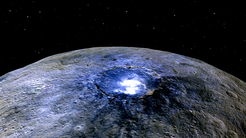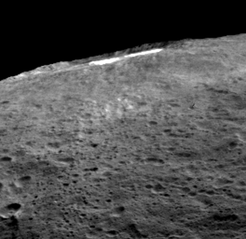Dwarf planet Ceres: water vapor in Occator crater
The Occator crater on the surface of dwarf planet Ceres is active: data from NASA’s Dawn mission indicate water sublimating from its center.
When the Sun shines into the Occator crater on the surface of the dwarf planet Ceres, a kind of thin haze appears above its brightest spot. This can be seen in images taken by the camera system aboard NASA’s Dawn space probe, which researchers under the lead of the Max Planck Institute for Solar System Research published on 9 December, 2015 in Nature magazine. The haze indicates that frozen water may exist near the surface . The bright spots in the Occator crater likely contain magnesium sulphates, a class of mineral salts. Many of the other bright areas on Ceres’ surface most likely by now consist solely of dried mineral salts. The new results show that since the birth of the Solar System frozen water has been able to survive not only in its furthest reaches, but also in the comparatively close asteroid belt.

An invisible border runs between the rocky planets of the inner Solar System and the gaseous giants further out. Around 4.5 billion years ago, water and other volatile substances evaporated from the regions close to the Sun leaving behind the inner planets Mercury, Venus, Earth and Mars as dry, rocky worlds. Only very far from the Sun these substances could survive. They exist until today in the gas planets and their icy moons. Even the water on Earth is a more recent migrant from this distant region. But where exactly is this “ice line” located today, and where was it in the past? Where in the Solar System has frozen water been able to survive?
NASA’s Dawn space probe is looking for answers to these questions in the asteroid belt – a region between the orbits of Mars and Jupiter that is populated by countless asteroids, some bigger, some smaller in size. At the beginning of this year, during the approach phase to Ceres, bright spots on the surface of this largest occupant of the asteroid belt were already firing the imaginations of scientists and laypersons alike.
Was it exposed ice? Or did salts give the bright spots their high reflectivity? “We are currently probably seeing remnants of an evaporation process exhibiting different stages in different locations. Perhaps we are witnessing the last phase of a formerly more active period”, says Andreas Nathues from the Max Planck Institute for Solar System Research in Göttingen, lead investigator of the camera team and first author of the study which will be published in Nature.
The light reflected into space by the all in all more than 130 bright spots differs greatly from that of other regions; it contains a higher proportion of blue, for example. This is shown by evaluations of the camera data taken with the aid of different color filters. “Comparisons with a large variety of materials which we examined in the laboratory indicate that among other materials hydrated magnesium sulphatesare to be found there,” explains second author Martin Hoffmann, scientist from the Max Planck Institute. These minerals also occur on Earth – sometimes at the rim of salt lakes.

The Occator crater has another noticeable feature. The central spot in the innermost part of the crater is much brighter than the other bright regions on the surface. It is located in a kind of “bowl within a crater” measuring ten kilometers in diameter and half a kilometer deep. “On some of our images, it is also possible to recognize a diffuse haze above the crater bottom,” says Nathues.
The haze occurs in a daily cycle whenever sunlight reaches the crater bottom. “Ice possibly evaporates from there and entrains small particles,” the researcher continues. The process resembles the outgassing of comets, but is currently proceeding at a rather leisurely pace and with no eruptions.
Indications of frozen water on Ceres have been known for some time. The density of the spherical body is too low for a purely rocky-metal interior, for example. At the beginning of last year, researchers in Michael Küppers’ team at the European Space Agency (ESA) reported indications for water vapor close to Ceres using the Herschel Space Observatory. In contrast to the new measurements, the gas was not spatially resolved, but its presence indicated by an absorption line in the light spectrum.
Dawn is now providing a more detailed look at Ceres. The measurements which have just been published originated partly from a distance of around 1470 kilometres – a mere stone’s throw on the cosmic scale. “The salts that appear on the surface of Ceres are strongly localized,” says Martin Hoffmann. They almost always occur in or near craters both big and small. The Occator crater which may contain ice is a particularly young example. The sharp-edged crater rim and the few impacts at the bottom of the crater indicate that it was formed only around 78 million years ago.
The second brightest structure on Ceres’ surface, the Oxo crater, which did not have a name until a few weeks ago and was therefore called “Feature A” in the study, is comparatively young as well and could also contain ice.

“The most plausible interpretation of our results is that there is a mixture of ice and salts under at least some parts of Ceres’ surface,” says Andreas Nathues. This material could be exposed by the impacts of medium-sized asteroids. The ice gradually evaporates until only salts and phyllosilicates are left.
“Our results show that subsurface ice was also able to survive in the asteroid belt, which is comparatively close to the Sun,” says Nathues. “The rocky surface layer protects it from the effects of the Sun.” The distance between our Sun and the dwarf planet Ceres is only around 414 million kilometers. Jupiter, whose icy moons emit water, is nearly twice as far away; and the comets which are rich in water spend most of their life even further away at the edge of the Solar System.

However, it is possible that Ceres is not the only ice reservoir in our planetary system that is close to the Sun. Spectral observations of the large asteroid Pallas, which orbits the Sun at a distance comparable to that of Ceres, suggest that the surfaces of both bodies have a similar composition.
The Dawn space probe began its journey into the asteroid belt, which is located between the orbits of Mars and Jupiter, in September 2007. In 2011, the probe arrived at the protoplanet Vesta and accompanied it for more than a year. On 6 March 2015, Dawn was caught into an orbit around the dwarf planet Ceres and has been gradually advancing to lower and lower orbits ever since. It will reach the lowest orbit in the middle of December and maintain it through next year. Dawn will then be a mere 375 kilometers above Ceres’ surface.
Dawn's mission to Vesta and Ceres is managed by the Jet Propulsion Laboratory for NASA's Science Mission Directorate in Washington. Dawn is a project of the directorate's Discovery Program, managed by NASA's Marshall Space Flight Center in Huntsville, Alabama. UCLA is responsible for overall Dawn mission science. Orbital ATK, Inc., of Dulles, Virginia, designed and built the spacecraft. JPL is managed for NASA by the California Institute of Technology in Pasadena. The framing cameras were provided by the Max Planck Institute for Solar System Research, Gottingen, Germany, with significant contributions by the German Aerospace Center (DLR) Institute of Planetary Research, Berlin, and in coordination with the Institute of Computer and Communication Network Engineering, Braunschweig. The framing camera project is funded by the Max Planck Society, DLR, and NASA.



